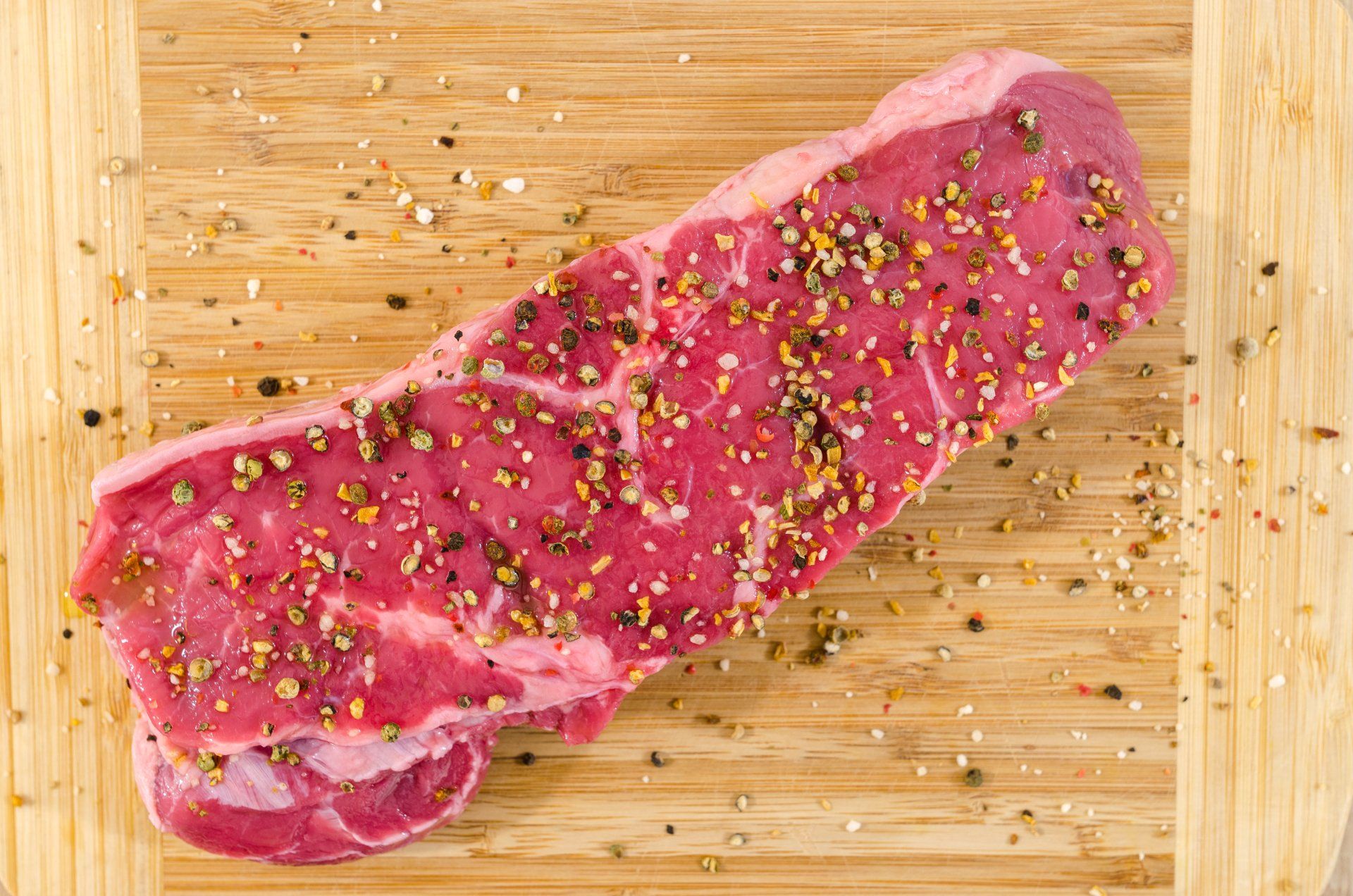HOW DOES YOUR DOG FOOD RATE: SCIENCE DIET
Hill’s Science Diet Adult (Dry)
(Original Source: The Dog Food Advisor)
Hill’s Science Diet Adult Dog Food receives the Advisor’s mid-tier rating of 3 stars. Science Diet Adult Advanced Fitness Chicken and Barley was selected to represent the other products in the line for this review.
Hill’s Science Diet Adult Advanced Fitness Chicken and Barley
Dry Dog Food
Estimated Dry Matter Nutrient Content
- Protein 010025
- Fat 010015
- Carbs 010053
Ingredients:
Chicken, whole grain wheat, cracked pearled barley, whole grain sorghum, whole grain corn, corn gluten meal, chicken meal, pork fat, chicken liver flavor, dried beet pulp, soybean oil, lactic acid, flaxseed, potassium chloride, iodized salt, calcium carbonate, choline chloride, vitamins (vitamin E supplement, l-ascorbyl-2-polyphosphate (source of vitamin C), niacin supplement, thiamine mononitrate, vitamin A supplement, calcium pantothenate, vitamin B12 supplement, pyridoxine hydrochloride, riboflavin supplement, biotin, folic acid, vitamin D3 supplement), minerals (ferrous sulfate, zinc oxide, copper sulfate, manganous oxide, calcium iodate, sodium selenite), oat fiber, taurine, mixed tocopherols for freshness, natural flavors, beta-carotene, apples, broccoli, carrots, cranberries, green peas
Fiber (estimated dry matter content) = 2.2%
Red items indicate controversial ingredients
Estimated Nutrient Content
| Method | Protein | Fat | Carbs |
|---|---|---|---|
| Guaranteed Analysis | 25% | 15% | NA |
| Dry Matter Basis | 25% | 15% | 53% |
| Calorie Weighted Basis | 22% | 32% | 46% |
| Calorie Weighted Basis Protein Fat Carbs | 22% | 46% | 32% |
Nutrient Type % Composition
| Nutrient Type | % Composition |
|---|---|
| Protein | 22 |
| Fat | 32 |
| Carbs | 46 |
The first ingredient in this dog food is chicken. Although it is a quality item, raw chicken contains about 80% water. After cooking, most of that moisture is lost, reducing the meat content to just a fraction of its original weight.
After processing, this item would probably account for a smaller part of the total content of the finished product.
The second ingredient is wheat. Like corn, wheat is an inexpensive and controversial cereal grain of only modest nutritional value to a dog.
For this reason, we do not consider wheat a preferred component in any dog food.
The third ingredient is barley. Barley is a starchy carbohydrate supplying fiber and other healthy nutrients. However, aside from its energy content, this cereal grain is of only modest nutritional value to a dog.
The fourth ingredient is sorghum. Sorghum (milo) is a starchy cereal grain with a nutrient profile similar to corn.
Since it is gluten-free and boasts a smoother blood sugar behavior than other grains, sorghum may be considered an acceptable non-meat ingredient.
The fifth ingredient is corn. Corn is another cereal grain and subject to the same issues as wheat (previously discussed).
The sixth ingredient is corn gluten meal. Gluten is the rubbery residue remaining once corn has had most of its starchy carbohydrate washed out of it.
Although corn gluten meal contains 60% protein, this ingredient would be expected to have a lower biological value than meat.
And less costly plant-based products like this can notably boost the total protein reported on the label — a factor that must be considered when judging the actual meat content of this dog food.
The seventh ingredient is chicken meal. Chicken meal is considered a meat concentrate and contains nearly 300% more protein than fresh chicken.
The next item is pork fat, a product from rendering pig meat.
Commonly known as lard, pork fat can add significant flavor to any dog food. And it can be high in linoleic acid, an omega-6 fatty acid essential for life.
Although it may not sound very appetizing, pork fat (in moderate amounts) is actually an acceptable pet food ingredient.
From here, the list goes on to include a number of other items.
But to be realistic, ingredients located this far down the list (other than nutritional supplements) are not likely to affect the overall rating of this product.
With six notable exceptions…
First, we find beet pulp. Beet pulp is a controversial ingredient, a high fiber by-product of sugar beet processing.
Some denounce beet pulp as an inexpensive filler while others cite its outstanding intestinal health and blood sugar benefits.
We only call your attention here to the controversy and believe the inclusion of beet pulp in reasonable amounts in most dog foods is entirely acceptable.
Next, soybean oil is red flagged here only due to its rumored (yet unlikely) link to canine food allergies.
However, since soybean oil is high in omega-6 fatty acids and contains no omega-3’s, it’s considered less nutritious than flaxseed oil or a named animal fat.
In addition, flaxseed is one of the best plant sources of healthy omega-3 fatty acids. Provided they’ve first been ground into a meal, flax seeds are also rich in soluble fiber.
However, flaxseed contains about 19% protein, a factor that must be considered when judging the actual meat content of this dog food.
Next, we find no mention of probiotics, friendly bacteria applied to the surface of the kibble after processing to help with digestion.
We also note the inclusion of peas. Peas are a quality source of carbohydrates. And like all legumes, they’re rich in natural fiber.
However, peas contain about 25% protein, a factor that must be considered when judging the meat content of this dog food.
And lastly, the minerals listed here do not appear to be chelated. And that can make them more difficult to absorb. Non-chelated minerals are usually associated with lower quality dog foods.
Hill’s Science Diet Adult Dry Dog Food - The Bottom Line
Judging by its ingredients alone, Hill’s Science Diet Adult Dog Food looks like an average dry product.
But ingredient quality by itself cannot tell the whole story. We still need to estimate the product’s meat content before determining a final rating.
The dashboard displays a dry matter protein reading of 25%, a fat level of 15% and estimated carbohydrates of about 53%.
As a group, the brand features an average protein content of 24% and a mean fat level of 14%. Together, these figures suggest a carbohydrate content of 54% for the overall product line.
And a fat-to-protein ratio of about 59%.
Below-average protein. Below-average fat. And above-average carbs when compared to a typical dry dog food.
When you consider the protein-boosting effect of the corn gluten meal, flaxseed and peas contained in this recipe and the use of pea protein and soybean meal in other recipes, this looks like the profile of a kibble containing a modest amount of meat.
Bottom line?
Hill’s Science Diet Adult is a plant-based dry dog food using a modest amount of named meats as its main sources of animal protein, thus earning the brand 3 stars.
Recommended.
Please note certain recipes are sometimes given a higher or lower rating based upon our estimate of their total meat content and (when appropriate) their fat-to-protein ratios.

Summertime means outdoor adventures for you and your furry friend. But lurking in those tall grasses is a tiny, yet potentially dangerous threat: grass seeds. These seemingly harmless little things can cause a world of trouble for your dog if not caught and removed promptly. How Grass Seeds Can Harm Your Dog Grass seeds are designed to stick, and they do just that to your dog's fur, paws, and even ears. Once embedded, they can cause a range of problems: Skin irritation: Grass seeds can cause redness, itching, and discomfort when lodged in your dog's fur or between their toes. Infection: If a grass seed penetrates the skin, it can carry bacteria, leading to painful and swollen infections. Serious complications: In rare but severe cases, grass seeds can migrate to other parts of the body, causing internal damage. Signs to Watch For Be on the lookout for these signs that your dog may have a grass seed problem: Excessive licking or chewing of paws Head shaking or tilting Pawing at the face Redness or swelling around the eyes or ears Discharge from the eyes or ears Lethargy or loss of appetite Preventing and Removing Grass Seeds Prevention is key to keeping your dog safe from grass seeds: Avoid walking your dog in tall grass, especially during dry weather when seeds are more likely to spread. Regularly check your dog's fur, ears, and paws for any signs of grass seeds. Trim the hair around your dog's paws and ears to reduce the risk of seeds getting caught. If you find a grass seed, try to remove it carefully with tweezers. If you can't easily remove the seed or if the area is red, swollen, or painful, contact your vet immediately. When to See a Vet It's important to seek professional help if: You can't remove the grass seed yourself. Your dog is showing signs of pain or discomfort. There's evidence of infection, such as redness, swelling, or pus. You suspect the grass seed has migrated to another part of the body. By taking precautions and being aware of the risks, you can help protect your furry friend from the dangers of grass seeds and ensure they enjoy a happy and healthy summer. Do you have any other questions about grass seeds or dog care?

Summer is a time for adventure, and what better way to experience the great outdoors than with your furry companion by your side? Hiking and camping trips are a fantastic way to bond with your dog, but venturing into flea and tick territory requires some extra preparation. Here's how to keep your pup safe and pest-free on your next outdoor adventure: Flea and Tick Prevention is Key Talk to your vet : Before you hit the trails, discuss flea and tick prevention with your veterinarian. They can recommend the best product for your dog based on their age, breed, and lifestyle. There are several options available, including topical medications, oral chews, and collars. Apply prevention medication : Follow the instructions on your chosen flea and tick preventative carefully. Be sure to apply it well in advance of your trip, according to the product label. Year-round protection : Many flea and tick medications offer year-round protection. This is important, even if you don't plan on spending a lot of time outdoors, as fleas and ticks can also be a problem indoors. Tick Check Time Daily examinations : Get into the habit of checking your dog for ticks every day, especially after spending time outdoors. Focus on areas like the ears, paws, armpits, and groin where ticks like to hide. Tick removal : If you find a tick on your dog, remove it promptly with a tick removal tool. Never try to pull it out with your fingers, as this can leave the mouthparts embedded in the skin. Be aware of tick-borne diseases : Lyme disease is a common concern in many areas. Talk to your vet about the risks in your area and whether a Lyme disease vaccination is recommended for your dog. Camping Considerations Choose your campsite wisely: Ticks are more prevalent in tall grass and wooded areas. If possible, set up camp in a clear, grassy area. Create a tick-free zone: Treat the campsite perimeter with an EPA-approved insect repellent safe for use around pets. Hiking Happy Trails Stick to the path : Stay on designated trails to avoid tall grass and brush where ticks are more likely to be hiding. Leave no trace: Clean up after your dog and dispose of waste properly. This helps to protect the environment and wildlife. Water, water, water: Just like you, your dog will need plenty of water to stay hydrated on a hike. Bring a portable water bowl and take frequent breaks to allow your dog to drink. By following these simple tips, you and your dog can enjoy a safe and happy adventure in the great outdoors. Remember, preparation is key! With a little planning and preventative measures, you can keep your furry friend safe from pesky fleas, ticks, and other outdoor hazards.

We all want our furry best friends to thrive, and a big part of that is ensuring they get the right fuel for their amazing bodies. But with shelves overflowing with dog food options, deciphering labels and picking the perfect protein and nutrition content can feel like cracking a doggy Da Vinci code. Fear not, fellow pet parents! This post will equip you with the knowledge to navigate the dog food aisle with confidence. Protein Power: Age Matters: Puppies are growing machines, so they need more protein (around 29%) than adult dogs (18-25%). Senior pups may also benefit from a slight protein bump to support muscle mass. Activity Level: The energetic athlete in your life? They likely burn through protein faster than a couch potato pup. Look for higher protein content (up to 30%) in active or working dog food. Source Matters: Just like for us, protein quality is key. Animal-based proteins like chicken, beef, or fish are generally more digestible and provide essential amino acids for your dog's growth and well-being. Beyond the Protein: Protein is a vital piece of the puzzle, but it's not the whole picture. Here's a quick rundown of other important nutrients: Fats: Provide energy and support healthy skin and fur. Look for balanced levels of omega-3 and omega-6 fatty acids. Carbohydrates: Fuel your dog's body and brain. Complex carbs are preferable to simple ones. Vitamins and Minerals: These micronutrients keep your dog's bodily functions running smoothly. Decoding the Label: The AAFCO (Association of American Feed Control Officials) guidelines ensure dog food meets minimum nutritional requirements. Here's what to watch for on the label: Guaranteed Analysis: This section lists the minimum percentages of protein, fat, fiber, and moisture in the food. First Ingredient: This should ideally be a named protein source, like chicken or salmon. Aesthetics: Avoid artificial colors, flavors, and preservatives. Remember: Consult Your Vet: They can recommend a food based on your dog's individual needs and any health concerns. Read Reviews: See what other pet parents have to say about different brands. Start Slow: When switching foods, gradually introduce the new one over a week to avoid tummy tr oubles. By understanding your dog's unique needs and wielding your newfound label-reading skills, you can choose a dog food that fuels their tail wags and keeps them happy and healthy for years to come. Remember, a happy pup makes a happy home! If you're still not sure, we are always willing to provide a FREE pet food consultation to help you find the right fit for your pet.

Spring has sprung! As the days get warmer and we spend more time outdoors with our furry friends, it's the perfect time to revamp their grooming routine. Shedding season is in full swing, and our pups need a little extra TLC to keep them looking and feeling their best. Here are some tips, tricks, and essentials to transform your dog from winter wooly bear to a sprightly spring pup! Brushing Bonanza: Brush, brush, brush! This is the golden rule of spring grooming. Regular brushing removes loose fur, prevents matting, and distributes natural oils for a healthy coat. Choose the right brush: Short-haired breeds might benefit from a bristle brush, while long-haired pups need an undercoat rake to remove that hidden fluff. Make it a bonding experience: Turn brushing into a pampering session. Use a gentle touch and positive reinforcement with treats or praise. Bath Time Bliss: Spring clean that fur! A bath can help remove winter grime, allergens, and that "doggy odor." But be gentle! Frequent baths can strip away natural oils. Use a dog-friendly shampoo: Skip human shampoos, which can irritate your pup's skin. Opt for a gentle, dog-specific formula. Rinse thoroughly: Leaving shampoo residue can cause itchiness. Rinse, rinse, rinse! Paw and Nose Care: Pawsitively essential! Spring means more walks and hikes, so check your dog's paws regularly for cracks, cuts, or debris. Keep paw pads moisturized with a dog-safe balm. Sniffing out dryness: Cold winter winds can leave your dog's nose dry and cracked. Apply a little petroleum jelly (safe for dogs!) to keep their nose happy and healthy. Bonus Tips: Fight the fleas and ticks: Spring is prime time for these pests. Talk to your vet about flea and tick prevention medication. Freshen up their breath: Dental hygiene is important! Ask your vet about dog-safe dental chews or sprays to keep their breath minty fresh. Spring Grooming Essentials: High-quality brush or comb suitable for your dog's coat type Gentle dog shampoo and conditioner Dog-safe ear cleaner (optional) Nail clippers (optional, consult your vet if unsure) Dog-safe paw balm Flea and tick prevention medication (consult your vet) With a little extra effort, your dog will be looking and feeling their best this spring! Remember, grooming is a great opportunity to bond with your furry friend. So crank up the tunes, grab your favorite brush, and get ready for a spaw day your pup will love!









